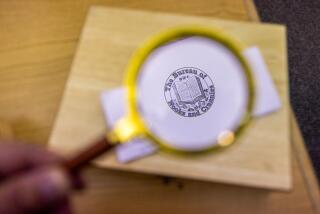Checking It Out
It’s not too cool for a teen to admit, but 15-year-old Lael Williams sighs and says it anyway: she sometimes--not always, but sometimes--comes to the Los Angeles Central Library voluntarily.
“Most kids only do it when they have to,” she explains. “Sometimes I’m here because I want to.”
Those are magic words for administrators who have worked hard to bust up the library’s stuffy, intimidating image and cultivate a more inviting atmosphere. From a Teen ‘Scape room stocked with computer games and mountain bike manuals to a treehouse-like reading perch with an airy view of the Biltmore Hotel, they’ve tried to create warm, welcoming spaces for all types of people.
From the looks of it, they’ve succeeded.
The hip courtyard hops at all hours: a retiree studies Nazi Germany while a writer wiggles her toes in the sun and a young man snoozes on the lawn. Just inside the front door, giggling schoolkids plop down on a marble step to swap picture books. A telemarketer scrolls through a computerized phone book in the lobby, looking for folks with Armenian last names. A technician researches his Aztec-Mayan heritage while a woman flips through a Korean-language magazine.
“It’s stunning,” says Adam Barr, a 30-year-old sitcom writer applying for his first library card so he can check out books on the Middle Ages. “It’s more than just books. It’s a full L.A. experience.”
The Central Library’s renaissance began in tragedy.
On April 29, 1986, flames ripped through rickety stacks crammed with books and exploded in a devastating blast. Paint peeled from concrete beams. Papers sizzled. Dozens of firefighters suffered smoke inhalation, burns and carbon monoxide poisoning as they fought to control the blaze.
In one sickening moment, the fiction department caught fire. Boom: A through L, half the collection, gone. Charlotte Bronte and Charles Dickens, Judith Krantz and Ray Bradbury--tens of thousands of volumes collapsed to a stinking heap of ash.
Librarians, sobbing, watched in horror.
“You started feeling almost ill,” Joan Bartel recalled.
“It was horrible anguish,” Helene Mochedlover said. “It’s a part of my life I’d just as soon forget.”
*
As Monday’s anniversary date approaches, however, few in the Los Angeles Public Library system can forget the conflagration, or fail to be impressed by the rebirth that followed.
“On the one hand, you don’t want to dwell on a disaster,” said Robert Reagan, director of public information. “But a lot of good things have happened because of the fire.”
Even before the last flames sputtered out, volunteers surged forward to help rebuild. The librarians who joined them picking through the rubble, hand-sponging every page of every smoke-charred book, were astounded at the depth of community support.
A Save the Books campaign soaked up donations. Sympathy calls rang in from across the country. Most importantly, the city transformed a $110-million library modernization project--planned long before the blaze--into a $214-million make-over. The threat to a cherished city service drew Los Angeles residents together, made them realize how much they treasured the Central Library.
That surge of affection carried through the years, and buoys librarians even today.
“Before the fire we had this great collection and we gave wonderful service, but we weren’t as beloved in the community as we are now,” said Mochedlover, now manager of the literature and fiction department.
*
To assess the library’s post-fire progress, just duck into the atrium elevator.
It’s lined with some of the 7 million catalog cards that once served as the library’s sole inventory.
They’re now officially obsolete.
No longer do readers have to flip through drawer after drawer of jumbled catalog cards to conduct their research. In the new library, computers guide visitors to the right department. An online circulation system allows readers to dial up the library from a home computer and figure out which branch has the titles they need. And vans shuttle books among the 66 branches, so a customer in Chatsworth can get a volume from San Pedro in two days or less.
The philosophy driving these changes is simple: “It doesn’t matter if you have the best collection around if people can’t use it,” Reagan explained.
The fire destroyed 370,000 books and documents, including the entire patents collection (containing diagrams and descriptions of every American invention), most of the science and technology department, and half the fiction. Some of the lost volumes were irreplaceable, like copies of the 19th century theater magazine “New York Dramatic Mirror.” Others were available only in different formats--such as the patents collection, which librarians found on microfilm but not in bound volumes.
Heartsick at the losses in the days following the fire, librarians nonetheless decided not to rebuild the collection title for title. Instead, they tried to modernize.
In the music department, for example, manager Romaine Ahlstrom found that schoolchildren no longer seemed as interested in piano or violin scores. So she focused on collecting the hottest new items: ethnic “world music” and guitar songs. Other librarians scrapped a planned research assistance center and instead opened the Teen ‘Scape room, crammed with Cliff Notes and science fiction books on tape.
*
“Having a facility like this makes people take us more seriously,” Ahlstrom agreed. “We had 80,000 people come through here on opening day and we haven’t looked back.”
Indeed, more than 2 million visitors have trekked to the Central Library since it reopened with huge fanfare in 1993.
“With all the concrete and steel around here, this is a welcome oasis,” explained legal secretary Shirley West, who likes to hang out in the garden on her lunch hour. Waving a bottle of water at the skyscrapers nearby, she added: “It’s kind of an escape from the chaos out there.”
More to Read
Sign up for Essential California
The most important California stories and recommendations in your inbox every morning.
You may occasionally receive promotional content from the Los Angeles Times.










